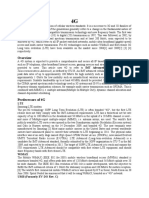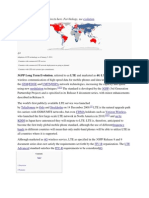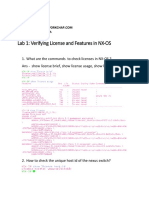What Is "LTE"?
What Is "LTE"?
Uploaded by
Radhika KalawatCopyright:
Available Formats
What Is "LTE"?
What Is "LTE"?
Uploaded by
Radhika KalawatOriginal Title
Copyright
Available Formats
Share this document
Did you find this document useful?
Is this content inappropriate?
Copyright:
Available Formats
What Is "LTE"?
What Is "LTE"?
Uploaded by
Radhika KalawatCopyright:
Available Formats
What is "LTE"?
LTE =European implementation of IMT (International Mobile Telecommunications) by ETSI (European Telecommunication Standards Institute). LTE, short for Long Term Evolution, is considered by many to be the obvious successor to the current generation of UMTS 3G technologies, which is based upon WCDMA, HSDPA, HSUPA, and HSPA. LTE is not a replacement for UMTS in the way that UMTS was a replacement for GSM, but rather an update to the UMTS technology that will enable it to provide significantly faster data rates for both uploading and downloading. LTE is a standard for wireless data communications technology and an evolution of the GSM/UMTS standards. The goal of LTE was to increase the capacity and speed of wireless data networks using new DSP (digital signal processing) techniques and modulations that were developed around the turn of the millennium. A further goal was the redesign and simplification of the network architecture to an IPbased system with significantly reduced transfer latency compared to the 3G architecture. The LTE wireless interface is incompatible with 2G and 3G networks, so that it must be operated on a separate wireless spectrum. LTE: Characteristics Packet oriented propagation only High data rates o Up to 300 Mbit/s Downlink o Up to 75 Mbit/s Uplink Flexible frequency assignment o About 40 frequency ranges o Varying frequency blocks (1.4, 3, 5, 10 and 20 MHz) small latency of 5ms between mobile phone and conventional telephone network optimized for travelling speeds of up to 15 km/h (up to 500km/h possible LTE employs Orthogonal Frequency Division Multiple Access (OFDMA) for downlink data transmission and Single Carrier FDMA (SC-FDMA) for uplink transmission
LTE Advanced Specified as LTE Release 10 Improved performance Data rate up to 1 GBit/s End-to-end delay 20 30 ms Enhancements: Carrier aggregation up to 5 * 20 MHz -> 100MHz Possible in contiguous and non-contiguous spectrum allocations Multiple Input, Multiple Output (MIMO) Up to 4 LTE antennas in LTE devices to use MIMO also for Uplink Base stations can be equipped with up to 8 antennas Support for relay node base stations Connected to base station only
Improve signal quality at cell borders Support of low power nodes such as picocells and femtocells for crowded areas WiMAX: Worldwide Interoperability for Microwave Access, standardized by IEEE 802.16 and WiMAX-Forum (more than 230 members, including AOL, Deutsche Telekom, Intel, Microsoft, Nokia) IEEE 802.16 FBWA (Fixed Broadband Wireless Access) is an alternative for broadband cable services like DSL; frequency range: initially 10-66 GHz, in assumption of LOS (line of sight) Enhancement IEEE 802.16a; frequency band: 2-11 GHz, NLOS (non line of sight) Enhancement IEEE 802.16e for MBWA (Mobile Broadband Wireless Access); frequency band: 2-6 GHz, NLOS
You might also like
- Communication (II) Mobile Report: Dr. Suzan ShokryDocument13 pagesCommunication (II) Mobile Report: Dr. Suzan ShokryDebashis DalaiNo ratings yet
- Lte OverviewDocument3 pagesLte Overviewrahulyadav243No ratings yet
- 01 LTE-EPS OverviewDocument47 pages01 LTE-EPS OverviewjulienkoffiNo ratings yet
- LTE OverviewDocument3 pagesLTE OverviewVishwaNo ratings yet
- LTE TutorialDocument13 pagesLTE TutorialsedjaliNo ratings yet
- Isn't It Time: For Your Network To Evolve?Document2 pagesIsn't It Time: For Your Network To Evolve?rrakeshgNo ratings yet
- 4G Refers To The Fourth Generation of Cellular Wireless Standards. It Is A Successor To 3G and 2G Families ofDocument6 pages4G Refers To The Fourth Generation of Cellular Wireless Standards. It Is A Successor To 3G and 2G Families ofvitchu_123No ratings yet
- Itu-R Cellular System: - Branded Samsung LTE ModemDocument9 pagesItu-R Cellular System: - Branded Samsung LTE ModemVivek NayeeNo ratings yet
- Lte Quick Guide Lte OverviewDocument18 pagesLte Quick Guide Lte OverviewAbdul Rahim ShaikhNo ratings yet
- Long Term Evolutio1 MaterialDocument7 pagesLong Term Evolutio1 MaterialPriyanshu KumarNo ratings yet
- Topic-1-Notes On 4GDocument4 pagesTopic-1-Notes On 4GfazfemtqeNo ratings yet
- 4G Refers To The Fourth Generation ofDocument12 pages4G Refers To The Fourth Generation ofsahithsindhuNo ratings yet
- LTEDocument23 pagesLTEShwetha Ha100% (1)
- 4G TechnologyDocument3 pages4G Technologyksikdar_eceNo ratings yet
- LTE Quick GuideDocument27 pagesLTE Quick GuideVishwaNo ratings yet
- C Refers To The Fourth Generation of Cellular Wireless Standards. It Is A Successor ToDocument10 pagesC Refers To The Fourth Generation of Cellular Wireless Standards. It Is A Successor ToPrabahar RamasamyNo ratings yet
- EDGE HSPA and LTE Broadband Innovation Powerpoint Sept08Document67 pagesEDGE HSPA and LTE Broadband Innovation Powerpoint Sept08JuanAlexanderGonzalesNo ratings yet
- Broadband: LTE (Long Term Evolution) Is A WirelessDocument2 pagesBroadband: LTE (Long Term Evolution) Is A Wirelessrushalin7No ratings yet
- 4G Predecessors and Discontinued Candidate SystemsDocument18 pages4G Predecessors and Discontinued Candidate SystemsrupeshukeNo ratings yet
- Background: 3GPP Long Term Evolution (LTE)Document9 pagesBackground: 3GPP Long Term Evolution (LTE)Madhu RaoNo ratings yet
- Long Term EvolutionDocument19 pagesLong Term EvolutionAbhishek JainNo ratings yet
- Long Term Evolution (LTE) : 4G Mobile BroadbandDocument16 pagesLong Term Evolution (LTE) : 4G Mobile BroadbandNarendra PattanayakNo ratings yet
- 4G Refers To The Fourth Generation of Cellular Wireless Standards. It Is ADocument16 pages4G Refers To The Fourth Generation of Cellular Wireless Standards. It Is ASagar JayashankarNo ratings yet
- 4G LTE Advanced TutorialDocument20 pages4G LTE Advanced TutorialGokul SmartNo ratings yet
- WiMAX Vs LTEDocument15 pagesWiMAX Vs LTEhemantpatil24No ratings yet
- LTE OverviewDocument25 pagesLTE OverviewSpinuNNo ratings yet
- 3G LTE TutorialDocument22 pages3G LTE TutorialAbhishek SinghNo ratings yet
- LTE and BeyondDocument30 pagesLTE and BeyondТарзан ПетковNo ratings yet
- Lec 01 Introduction Modern Communications SystemsDocument27 pagesLec 01 Introduction Modern Communications Systemsmu7senanNo ratings yet
- Beyond 3G: An Extract From 3GPPDocument13 pagesBeyond 3G: An Extract From 3GPPVikram KolanuNo ratings yet
- Practical 6 Introducing 4G Technology: BackgroundDocument7 pagesPractical 6 Introducing 4G Technology: BackgroundIshant GohilNo ratings yet
- Long Term Evolution: D.A.C.H Dandeniya ET/07/6853Document9 pagesLong Term Evolution: D.A.C.H Dandeniya ET/07/6853Tharindu MadushankaNo ratings yet
- LTE Introduction in 15 Bullet PointsDocument1 pageLTE Introduction in 15 Bullet PointsSudipta DasNo ratings yet
- Introduction To Lte and Its Unique TechnologiesDocument7 pagesIntroduction To Lte and Its Unique TechnologiesMohamed HussienNo ratings yet
- 4G Basics OverviewDocument13 pages4G Basics OverviewrajeshkarraNo ratings yet
- Long Term Evolution by RAMDocument17 pagesLong Term Evolution by RAMRamesh YedurlaNo ratings yet
- LTE EvolutionDocument20 pagesLTE EvolutionDjiems GauthierNo ratings yet
- LTE - Network and ProtocolDocument16 pagesLTE - Network and ProtocolTechnical saadNo ratings yet
- MC-04 LTE and BeyondDocument28 pagesMC-04 LTE and BeyondIp PangNo ratings yet
- Presentation ON 4G-Technology: Presented By: Sonia Choudhary B. E. Ivth Year I.T GvsetDocument25 pagesPresentation ON 4G-Technology: Presented By: Sonia Choudhary B. E. Ivth Year I.T Gvsetaskiran1237807No ratings yet
- Department of Electronics and Telecommunication: Pillai College of Engineering New Panvel - 410 206Document16 pagesDepartment of Electronics and Telecommunication: Pillai College of Engineering New Panvel - 410 206Venkatraman SubramanianNo ratings yet
- Unit 6 LTE & 5GDocument6 pagesUnit 6 LTE & 5Gamey vermaNo ratings yet
- LTE ArchitectureDocument80 pagesLTE ArchitecturesotodolNo ratings yet
- Capesso Symena LTE Network DesignDocument18 pagesCapesso Symena LTE Network Designhaidine_DDBonnNo ratings yet
- MC Mod 6Document83 pagesMC Mod 6wilaxin634No ratings yet
- Iclterpop Section 1Document33 pagesIclterpop Section 1Witto PereNo ratings yet
- Presentation ON 4G-Technology: Presented By: Sonia Choudhary B. E. Ivth Year I.T GvsetDocument25 pagesPresentation ON 4G-Technology: Presented By: Sonia Choudhary B. E. Ivth Year I.T GvsetShahbaz AlamNo ratings yet
- LTE and LTE-Advanced Factsheet: The "Long Term Evolution" of UMTSDocument16 pagesLTE and LTE-Advanced Factsheet: The "Long Term Evolution" of UMTSDeepayan ChoudhuryNo ratings yet
- WCDMA Air InterfaceDocument54 pagesWCDMA Air InterfaceRookie2No ratings yet
- Superbrza LTE Mobilna Mreža I Minimalni Servisi Za Prenos Podataka, Poruka I GovoraDocument18 pagesSuperbrza LTE Mobilna Mreža I Minimalni Servisi Za Prenos Podataka, Poruka I GovoraParalija KenanNo ratings yet
- LTE & LTE AdvDocument10 pagesLTE & LTE AdvVIKAS NIGAMNo ratings yet
- Long Term Evolution (LTE) MAR2023Document17 pagesLong Term Evolution (LTE) MAR2023Janet MuendiNo ratings yet
- Communication Based Train Control SystemDocument25 pagesCommunication Based Train Control SystemArthiNo ratings yet
- Concise Guide to OTN optical transport networksFrom EverandConcise Guide to OTN optical transport networksRating: 4 out of 5 stars4/5 (2)
- Modeling and Dimensioning of Mobile Wireless Networks: From GSM to LTEFrom EverandModeling and Dimensioning of Mobile Wireless Networks: From GSM to LTENo ratings yet
- CompTIA Network+ (N10-009) Study Guide: Comprehensive Exam Preparation and Key Concepts for Network ProfessionalsFrom EverandCompTIA Network+ (N10-009) Study Guide: Comprehensive Exam Preparation and Key Concepts for Network ProfessionalsNo ratings yet
- VHDL Verilog DifferencesDocument5 pagesVHDL Verilog DifferencesRadhika KalawatNo ratings yet
- Shallow Junction Formation by Polyatomic Cluster Ion ImplantationDocument4 pagesShallow Junction Formation by Polyatomic Cluster Ion ImplantationRadhika KalawatNo ratings yet
- Mtech Syllabus0405Document136 pagesMtech Syllabus0405Radhika KalawatNo ratings yet
- Function To Accept and Display A CharacterDocument34 pagesFunction To Accept and Display A CharacterRadhika KalawatNo ratings yet
- Cad PD AssignmentDocument19 pagesCad PD AssignmentRadhika KalawatNo ratings yet
- Index: S.No. Date Title Sign RemarkDocument19 pagesIndex: S.No. Date Title Sign RemarkRadhika KalawatNo ratings yet
- Vi EditDocument5 pagesVi EditRadhika KalawatNo ratings yet
- Wireless Unified 108AG Access Point: DWL-8500APDocument4 pagesWireless Unified 108AG Access Point: DWL-8500APEdgar OcantoNo ratings yet
- SFP TypesDocument18 pagesSFP Typessuraiyya begumNo ratings yet
- Delay Performance of GoIP DeviceDocument4 pagesDelay Performance of GoIP DeviceAhmed Bahig MohamedNo ratings yet
- VXLAN With Static Ingress Replication and Multicast Control PlaneDocument19 pagesVXLAN With Static Ingress Replication and Multicast Control PlaneNguyen LeNo ratings yet
- 1.3 7 - Multi Chassis Link Aggregation (MLAG)Document16 pages1.3 7 - Multi Chassis Link Aggregation (MLAG)francescoNo ratings yet
- http192 168 1 1rpsys HTMLDocument1 pagehttp192 168 1 1rpsys HTMLKhalid BouchaibNo ratings yet
- HDLC Analysis/Playback/Simulation: Hex Dump View Displays The Frame Information in HEX and ASCII FormatDocument2 pagesHDLC Analysis/Playback/Simulation: Hex Dump View Displays The Frame Information in HEX and ASCII FormatAnonymous iiKouoqLOPNo ratings yet
- Jeopardy 3 9Document33 pagesJeopardy 3 9Pablo V SalazarNo ratings yet
- Performance Analysis of Dynamic Routing Protocols Using Packet TracerDocument5 pagesPerformance Analysis of Dynamic Routing Protocols Using Packet TracerSyafira MardhiyahNo ratings yet
- Wireless and Mobile Network Architectures Lin, Yi Bing, 1961 ChlamtacDocument568 pagesWireless and Mobile Network Architectures Lin, Yi Bing, 1961 Chlamtacgdeepanjali1411No ratings yet
- Ethernet Oam OverviewDocument10 pagesEthernet Oam Overviewccie123456No ratings yet
- 3HH-10693-AAAA-TQZZA-03-System Description For FD 24Gbps NT R4 4 XDocument528 pages3HH-10693-AAAA-TQZZA-03-System Description For FD 24Gbps NT R4 4 XStavros SotiriadisNo ratings yet
- 60b391e0a7db6 - 1622381024 - Nexus Workbook Ver 1 7 Networkchap ComDocument100 pages60b391e0a7db6 - 1622381024 - Nexus Workbook Ver 1 7 Networkchap Comrashmi mNo ratings yet
- 3G Security Principles: - Build On GSM Security - Correct Problems With GSM Security - Add New Security FeaturesDocument21 pages3G Security Principles: - Build On GSM Security - Correct Problems With GSM Security - Add New Security FeaturesAhmed TarekNo ratings yet
- 10 - NetNumen U31 R22 (V12.15.10) Online Help (CTN NE Management) PDFDocument659 pages10 - NetNumen U31 R22 (V12.15.10) Online Help (CTN NE Management) PDFDavoodNo ratings yet
- Sol14 (Solutions To Chapter 14)Document2 pagesSol14 (Solutions To Chapter 14)luda392100% (1)
- Question BankDocument25 pagesQuestion Bankmokara borisNo ratings yet
- WM 5.4.2 Release NotesDocument36 pagesWM 5.4.2 Release Notesoneota123No ratings yet
- DynaFlex DM2X R3.20 150119 1459 UMDocument135 pagesDynaFlex DM2X R3.20 150119 1459 UMpepe fernandezNo ratings yet
- 5G MIMO ConfigurationDocument49 pages5G MIMO Configurationturi313No ratings yet
- EnGenius Technologies Sales / Product KitsDocument34 pagesEnGenius Technologies Sales / Product KitswasiuddinNo ratings yet
- Prevent Session Hijacking PDFDocument6 pagesPrevent Session Hijacking PDFnbprNo ratings yet
- Cisco Ccie R - S Book Reading ListDocument4 pagesCisco Ccie R - S Book Reading ListGauthamNo ratings yet
- 5.high Speed LANDocument29 pages5.high Speed LANUtsav Kakkad100% (1)
- Implementing Best Practices For Vlan Topologies: Defining VlansDocument66 pagesImplementing Best Practices For Vlan Topologies: Defining VlansArun JoyNo ratings yet
- Media Access ControlDocument26 pagesMedia Access ControlHappy HoursNo ratings yet
- LabS2 RIPv2 EIGRP OSPFDocument1 pageLabS2 RIPv2 EIGRP OSPFhuyandwhoNo ratings yet
- Computer Network and Security, All The Module Question Bank VtuDocument3 pagesComputer Network and Security, All The Module Question Bank VtubibliophileonthesamepageNo ratings yet
- Meraki Datasheet Ms 220 320 OnlyDocument11 pagesMeraki Datasheet Ms 220 320 OnlyRick RutledgeNo ratings yet
- A30Document73 pagesA30johncena90No ratings yet
































































































